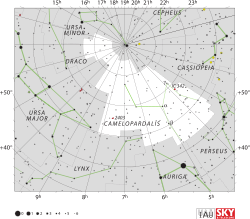Camelopardalis
constellation in the northern celestial hemisphere
Camelopardalis is a constellation in the northern sky. It is hard to see because it is not very bright. It is also very large. It was created and named by the Dutch astronomer named Petrus Plancius in 1612. It represents a giraffe.[2] Its brightest star, β Cam, has a magnitude of only 4.03. This means that Camelopardalis is very dark. People who live in cities cannot see Camelopardalis.
| Constellation | |
 | |
| Abbreviation | Cam[1] |
|---|---|
| Genitive | Camelopardalis[1] |
| Pronunciation | /kəˌmɛləˈpɑːrdəlɪs/, genitive the same |
| Symbolism | the Giraffe[1] |
| Right ascension | 6 |
| Declination | +70 |
| Quadrant | NQ2 |
| Area | 757 sq. deg. (18th) |
| Main stars | 2, 8 |
| Bayer/Flamsteed stars | 36 |
| Stars with planets | 4 |
| Stars brighter than 3.00m | 0 |
| Stars within 10.00 pc (32.62 ly) | 3 |
| Brightest star | β Cam (4.03m) |
| Messier objects | 0 |
| Meteor showers | October Camelopardalids |
| Bordering constellations | Draco Ursa Minor Cepheus Cassiopeia Perseus Auriga Lynx Ursa Major |
| Visible at latitudes between +90° and −10°. Best visible at 21:00 (9 p.m.) during the month of February. | |

References
change- ↑ 1.0 1.1 1.2 Ridpath, Ian (2001). Stars and Planets Guide. Princeton University Press. pp. 92–93. ISBN 0-691-08913-2.
- ↑ Ridpath, Ian. "Camelopardalis: the Giraffe". Star Tales. Retrieved 27 January 2013.